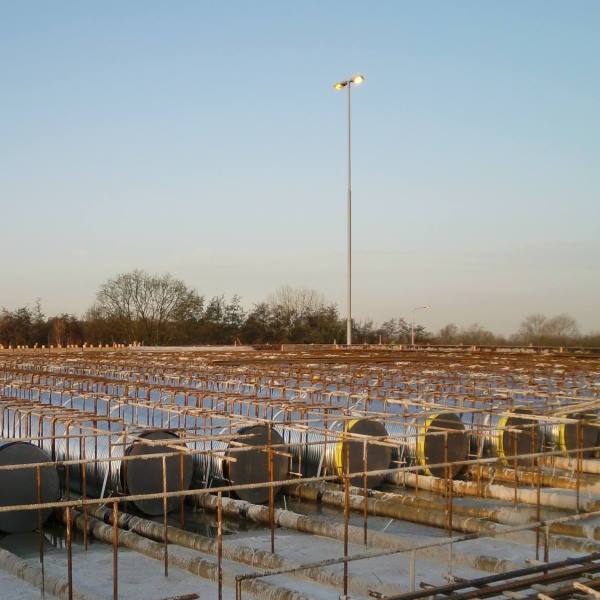Void Forming Tubes
Build cost-effectively
Displacement pipes make it possible to produce hollow bodies in hollow slab bridges and ceilings safely, quickly and cost-effectively. The dimensional accuracy, tightness and form stability of these industrially manufactured recesses ensure that the pre-calculated static values are implemented in the structure.
Light and flexible
Despite their lightweight construction, the displacement pipes can be laid and concreted without reinforcement. At the same time, the corrugated profile creates a certain flexibility, which means that displacement pipes can also be laid in a curved course. Despite this property, the pipe is so longitudinally rigid that the distances for buoyancy protection can primarily be adjusted to the strength of the respective anchoring. To secure the displacement pipes against buoyancy, it is recommended to use the specially developed Hydra one- and two-point anchors. They are statically tested and guarantee the greatest possible freedom from marks, especially protection against rust stains on the underside of the ceiling.
The different options for assembling and disassembling the anchors take the different conditions of the individual structures into account. This makes it possible to attach and remove the buoyancy anchor exclusively from above if the conditions make it impossible or very difficult to work from below.
Applications

Use in bridge construction
By using wbr pipes as hollow bodies in bridges, savings can be made in reinforcing steel and concrete. This in turn leads to a significant reduction in weight. The resulting “slimmer” structures fit better into the landscape and therefore require fewer interventions. Hydra displacement pipes thus enable economical construction not only in the foundation area of a bridge, but also in the actual structure.

Use in the ceiling area
The use of displacement pipes from wbr makes modern construction with concrete more economical and faster – whether working with in-situ concrete, ready-mixed concrete or a combination of both. The versatile products and the many different designs open up new paths. Even with solutions that are not based on conventional schemes.

Use in hollow slabs (slab ceilings)
Thanks to their finely tuned range of dimensions, displacement pipes (hollow elements) can also be used in commercial or industrial construction when it comes to creating modern and slim buildings.
Typs

Pipe type 7631.01
Thanks to their finely tuned range of dimensions, our displacement pipes (hollow elements) can also be used in commercial or industrial construction when it comes to creating modern and slim buildings.
Materials: bare steel, galvanized steel, coated steel
Available in diameters from 400-1500 mm.
As a single pipe in max. delivery lengths of 6.00 m
Extra lengths on request. Length tolerance ± 50 mm

Tubes for hollow slabs
Build efficiently, cost-effectively and conserve resources: With the Röhbrau pipes you save weight and material, also through low ceiling thicknesses. The load-bearing capacity is still maintained, larger spans are possible. Material: steel, galvanized steel
Available in diameters from 200 – 400 mm. See technical data
As a single pipe in max. delivery lengths of 6.00 m. Extra lengths on request.
Length tolerance ± 50 mm
– Weight savings
– Material savings, low ceiling thicknesses
– Load-bearing capacity is maintained, larger spans
– Resource-saving
End caps, end cones, plug connectors

Optimal accessories for optimal work.
End caps ensure a clean, tight closure of the displacement pipes used. End cones are available as alternatives. Matching plug-in sleeves are also available.
Anchoring

Anchoring in general
To secure the displacement pipes against buoyancy, it is recommended to use the Hydra one- and two-point anchors specially developed for this purpose. They are statically tested and guarantee the greatest possible freedom from marks, especially protection against rust stains on the underside of the ceiling. The various options for assembling and disassembling the anchors take the different conditions of the individual structures into account.
Two-point anchoring with locking tension band
Displacement pipes must be secured against buoyancy in the fresh concrete before being cast in concrete. This can be done by temporarily applying a load, but this would place additional strain on the formwork and support structure and hinder the concreting work. The better solution is therefore to anchor the pipes below the formwork. In practice, the magnitude of the buoyancy forces is often underestimated, especially with pipes of larger diameters. It is therefore advisable to use statically tested anchoring systems. Hydra anchors are statically tested and have proven themselves in practice to be a cost-effective method.
Permissible anchor spacing and installation instructions, as well as other accessories on request.
Spacers

Removing traces from concrete
The holes left in the concrete by the anchoring rods after the formwork has been removed can be quickly and cleanly closed with plastic plugs. This means that the requirements placed on the visible surface of concrete structures can be optimally met.

Spacers
Hydra spacers are supplied as standard with fibre-reinforced concrete blocks into which the spacer is inserted on site. In this variant, the end of the foot is 30 mm away from the free concrete surface (DIN 1045). This prevents rust spots from forming later on
How can we help you?
Do you have any questions? We are happy to help you by phone or email!
wbr Rohr- und Bauelemente GmbH
Otto-Hahn-Straße 17
D 75248 Ölbronn-Dürrn





